
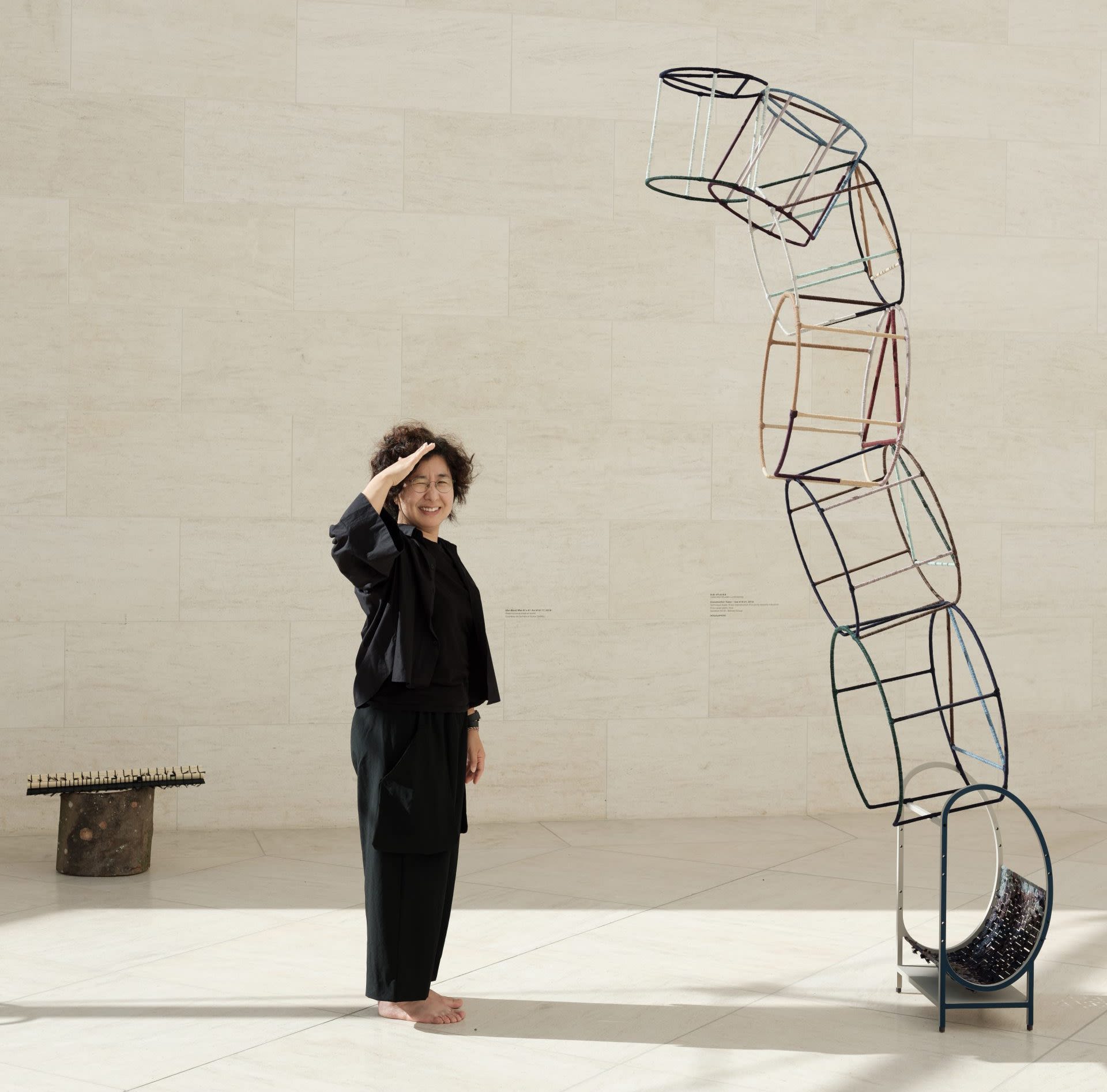
In memoriam of the artist
Suki Seokyeong Kang
1977–2025
We at Commonwealth and Council are extremely honored to have known, worked with, and loved, the woman, artist, mother, daughter, wife and friend, that was Suki Seokyeong Kang.
Photo: Albrecht Fuchs
Suki Seokyeong Kang (b. 1977, Seoul; d. 2025, Seoul) received an MA in Painting at the Royal College of Art, London (2012) and an MFA and a BFA in Oriental Painting at Ewha Womans University, Seoul (2002, 2000). Solo exhibitions have been held at Museum of Contemporary Art Denver (2025); Leeum Museum of Art, Seoul (2023); Musée d'Art Contemporain du Luxembourg (2019); Seoul Museum of Art (2019); Institute of Contemporary Art, Philadelphia (2018); Audiovisual Pavilion, Seoul (2015); and Gallery Factory, Seoul (2013). Selected group exhibitions have been held at Museum of Contemporary Art Chicago (2021); 58th Venice Biennale (2019); 10th Liverpool Biennial (2018); 12th Shanghai Biennale (2018); 12th and 10th Gwangju Biennale (2018, 2016); Bloomberg New Contemporaries, London (2012); MAK Center for Art and Architecture, Los Angeles (2018); Museum of Modern and Contemporary Art, Seoul (2017); Villa Vassilieff, Paris (2016); and Seoul Museum of Art (2014). Kang is a recipient of Baloise Art Prize (2018) and Songeun Art Award (2013).
Kang’s work is in the collections of Amorepacific Museum of Art, Seoul; Leeum Museum of Art, Seoul; Los Angeles County Museum of Art; Mudam Luxembourg; Museum of Contemporary Art Chicago; Museum of Modern Art, New York; National Museum of Modern and Contemporary Art, Seoul; Princeton University Art Museum; Seoul Museum of Art; Toledo Museum of Art; and Walker Art Center, Minneapolis.
I’m Blue (If I Was █████ I Would Die): American Artist and Robin D.G. Kelley in conversation.
Closed captions available; transcription available by request.
Permanent Visitor: Kang Seung Lee and Joan Kee in conversation.
Closed captions available; transcription available by request.
keeping: Yosimar Reyes and rafa esparza in conversation.
Closed captions available.
En la milenrama confiamos: A discussion with Carolina Caycedo, Sofía Gallisá Muriente, and Christian Toscano.
Closed captions available.
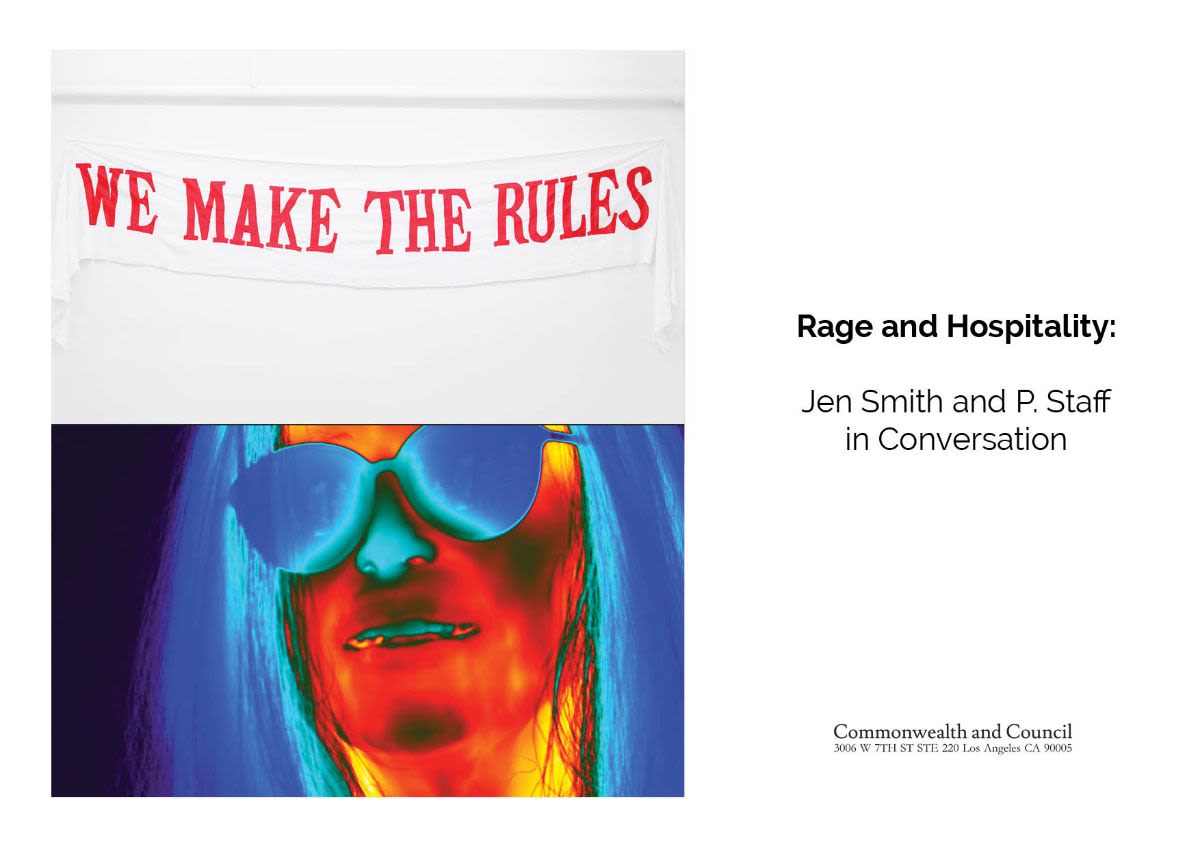
Click here to access the illustrated transcript.
Rage and Hospitality: Jen Smith and P. Staff in Conversation
A Zoom recording of an informal discussion between Jen Smith and P. Staff on the occasion of Smith's exhibition at Commonwealth and Council, Take Care.
This is a recording of a Zoom discussion that took place on November 21, 2020. A transcription of the video is available at the link above.
Operating at the interstices between painting and photography, Yamaoka’s work uses silver mylar as both ground and surface: the film on which an image emerges. Urethane resin is cast around or poured on mylar, and its reflective coating inevitably captures the viewer’s body in space—implicating them as subject, and as editor. The unstable image, distorted and in flux due to the viewer’s shifting position and changing light, pulls it into abstract synthesis: a body plastiglomerate whose unsettled reflection engenders a liminal moment of appearance and disappearance, recognition and denial. This polyphony of outcomes renders Yamaoka’s paintings less static objects than networks of encounter, comprising the chains of happenstance linking casts and pours of resin with the meeting of viewer and object.
Carrie Yamaoka (b. 1957, Glen Cove, NY; lives and works in New York, NY) received a BA at Wesleyan University in 1979 and attended the Tyler School of Art, Rome, Italy from 1977-78. Recent solo exhibitions were held at Ulterior Gallery, New York (2019); Henry Art Gallery, University of Washington, Seattle (2019); and Lucien Terras, New York (2017). Yamaoka has been featured in group exhibitions at Centre Pompidou, Paris (2020); Transmitter, New York (2019); Albertz Benda, New York (2019); PARTICIPANT INC, New York (2019); Kunstverein Rosa-Luxemburg-Platz, Berlin (2019); Leslie-Lohman Museum, New York (2018, 2017); Fondation Ricard, Paris (2018); Galerie Crevecoeur, Marseille (2018); Center for Contemporary Art Futura, Prague (2016); and MoMA PS1, Queens (2015). She has received grants and fellowships from the John Simon Guggenheim Memorial Foundation (2019), Anonymous Was A Woman Foundation (2017), Rutgers Center for Innovative Printmaking (1990), and Art Matters (1988), and has participated in residencies at Painting Space 122, New York (2009); Fenenin El-Rahhal/Nomadic Artists Working Artists’ Summit, Egypt (2006); Braziers International Artists Workshop, Oxfordshire, UK (1998, 1995); and Yaddo, Saratoga Springs, New York (1986). She is a founding member of the queer art collective fierce pussy. Yamaoka’s work was featured in arms ache avid aeon: Nancy Brooks Brody / Joy Episalla / Zoe Leonard / Carrie Yamaoka: fierce pussy amplified, Chapters 1- 4 at Beeler Gallery, Columbus College of Art and Design, Ohio and Chapter 5 at Institute of Contemporary Art Philadelphia, PA. A new chapter of the ongoing project is slated to open in February 2022 at Palais de Tokyo, Paris.
Jonah Groeneboer (b. 1978) is a New York-based interdisciplinary transgender artist working in abstraction to address the politics of representation. He developed this strategy to examine the expectation that the transgendered body be readily available for visual scrutiny. The work offers a slowed-down experience where minute shifts over time replace binary understandings. He creates aesthetically paired down forms that respond to or are dependent on the architecture and light conditions of the exhibition space, implicating the position of viewership and the environment. Forces such as tension, gravity, light and sound are both structural and material in his work. Groeneboer’s sculptures and diptychs are often described as unphotographable. These materially spare works are used by Groeneboer to question visual perception’s capacity to produce complete comprehension. The impossibility of seeing in totality is an integral concept in his work, providing a counterpoint to Minimalism by its insistence on a political position within these contingencies.
His work has shown at David Zwirner (2018), Boston University Galleries (2017), MoMA (2016), Art in General (2016), the Queens Museum (2016), CCS Bard Hessel Museum of Art (2016), MoMA PS1(2015), Contemporary Art Museum Houston (2015), Platform Centre for Photographic and Digital Arts in Winnipeg(2015), Andrew Edlin Gallery, NY (2013), Shoshawna Wayne Gallery, CA (2010), and Exile, Berlin(2010) Among others. Essays and Reviews on his work have appeared in the New York Times, the New Yorker, Art 21.com, Mute Magazine, Artforum.com Temporary Art Review, Art Journal, and in Pink Labour on Golden Streets “Appearing Differently: Abstraction’s Transgender and Queer Capacities.” Residencies include Ox-Bow School of Art, the Fire Island Artist Residency, and Recess. He has received travel (2018) and project grants (2019) from Canada Council for the Arts.
As a writer, he has participated on panels and in symposiums at the Whitney Museum of Contemporary Art in conjunction with Zoe Leonard’s Survey, and the Beeler Gallery for Arms Ache Avid Aeon: Fierce Pussy Amplified and is a contributing critic for Artforum.com. He currently teaches in the MFA program in the School of Art, Media, and Technology at the New School.
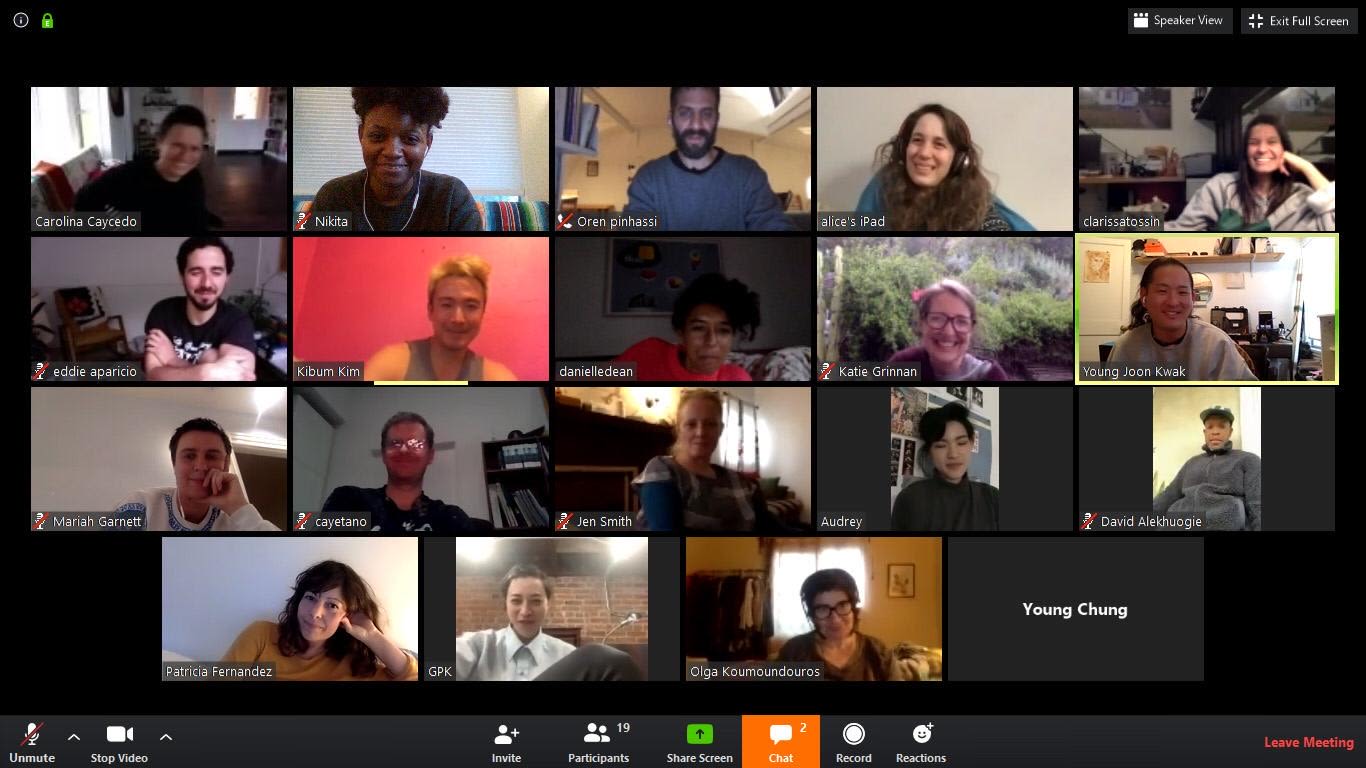
Thank you for the overwhelming and positive response to the first session of CwC Summer School. Please stay tuned for further iterations of the program. Until then, we hope that the discussions and conversations that rose from meetings can continue informally.
Recordings of selected Zoom sessions are available below, as well as an archived course listing.
Led by Alison O'Daniel and Kibum Kim
The discussion group will examine the various institutions that make up the art world (schools, galleries, museums) and explore how these systems inform art-making, exhibition-making, marketization of art, and institutional validation. Some issues that will be discussed include: systems of exchange in the art world, pedagogical ethos in/neoliberalization of art education, legibility of artworks in the market, the artist as “brand,” globalization and its manifestations in homogenization and colonialism, issues of the archive, and the notion of the "canon.”
For the first session, we will be discussing the education system in the art world. Some topics for discussion include:
The mind/body dichotomy in the classroom and how it reinforces extant power structures, often resulting in further marginalization of the oppressed
Growth of the MFA industry and the professionalization of the artist in the age of globalization and neoliberalism (*Paul Freire's banking model of education)
Current education system/art market trends and MFA programs
Other forms of legitimating institutional markers (e.g. the residency circuit)
Alternative models
The artist Maura Brewer, who co-founded the experimental school Arts Research Collective, will join the conversation. Several California College of the Arts Student Union members will also offer a teach-in on inclusive zoom communication practices and facilitate the conversation.
Chat transcript available here
Auto-captioned recording available via Youtube
For the second session, we will be discussing the museum sphere in the art world. Many of us have been reading and engaging in great, incisive, and much needed discussions about systemic inequities ingrained and sustained in museums. We would like to consider how such colonial, patriarchal, and white supremacist tendencies may manifest in everyday operations in museums today.
Some topics for discussion include:
The Imperialist genesis of museums and ties to the Enlightenment/modernity/Anthropocene drive
The raison d'etre of museums and the public good
The collection—the archive, the record. What gets preserved, historicized, and institutionally validated through museums, and how?
How are knowledge and truth shaped through museological practices?
What should be collected in museums in 2020? And how?
How can we (re)think the repatriation question?
Contemporary trends:
Proliferation of private museums; increasing influence of collector patrons
Boom in interest in contemporary art
The artist Gala Porras-Kim, from the Commonwealth and Council family, will join the conversation to speak on her recent projects working with collections at LACMA and MOCA. Several California College of the Arts Student Union members will also offer a teach-in on inclusive zoom communication practices and facilitate the conversation.
Chat transcript available here
Auto-captioned recording available via Youtube
For the third session, we will be discussing the market, in particular how primary market galleries work with artists today. Here we return to our original assumption that framed our discussions this past month: that the art world is an industry that is profoundly ambivalent about its commercial, transactional aspects. Art dealers often walk a tightrope—working to create markets for their artists while emphasizing that the work does not capitulate to commercial taste. The art-for-art's-sake myth in turn helps build more market demand. We will consider how the growth of the contemporary art market in the new millenium has chipped away at the art world's anti-market stance and imagine how the art world can still be a liberated laboratory in which to explore alternatives to capitalist models.
Some topics for discussion include:
Denegation of the market in the art world
Hostile worlds view v. neoclassical view
Gift economy in art world
How the emphasis on fostering non-transactional relationships has made the art world an industry rife with unpaid labor
PROPERTY
Why do we buy art? What does it mean to own art?
Ownership. Alienation (property defined by right to alienate)
What is “stewardship”
Globalization and neoliberalism
Flattening of contemporary artmaking
The colonial extraction in the Global South as the art market tries at “diversification”
If you would like to peruse what we have been reading and thinking about, below are some links and pdfs.
RESOURCES:
Goodbye Art World, Hello Art Industry - Tim Schneider
READINGS available here: drive.google.com/drive/folders/1I8pn6ZNqDW6KMBWWGe7GubkHd91xKUU0?usp=sharing
Auto-captioned recording available via Youtube
Led by Danielle Dean and Nikita Gale
Danielle Dean and Nikita Gale will facilitate an informal discussion that takes Kathryn Yusoff's A Billion Black Anthropocenes or None as a point of departure. Participants will be invited to explore ideas presented in Yusoff's text, some of which include antiblackness and the legacy of colonialism; western understandings of environment, land and property; extraction, and the production of value.
Link to read online: https://manifold.umn.edu/projects/a-billion-black-anthropocenes-or-none
Danielle Dean and Nikita Gale facilitate an informal discussion that takes Kathryn Yusoff's A Billion Black Anthropocenes or None as a point of departure. Participants were invited to explore ideas presented in Yusoff's text, some of which include antiblackness and the legacy of colonialism; western understandings of environment, land and property; extraction, and the production of value.
Below, please find a few notes that we hope will guide our thinking during this session. As we were talking about the book, a few things seemed to emerge as primary ideas that interested us in relation to our artistic practices. Here is a smattering of notes from one of our conversations which we hope to elaborate upon in collaboration with you as participants in this discussion:
Yusoff’s argument can be applied to most colonial systems--the subject is always white and male.
What are the possibilities of considering Humans and Non-humans as material/matter--as rocks, plants, objects, or non-life forms?
The history of slavery and its relationship to gold/minerals; in particular, Elmina Castle in Ghana
The use of categories and categorization in the technique of geology. What is the process of defining biological and geological?
“Rethinking the earth”
Black bodies as properties of “enjoyment… labor, violence, energy…”
Extraction of material from the earth and extraction of creative labor/energy
… what about fossils (and fuel and energy)
Chat transcript available here.
An open conversation led by Olga Koumoundouros and Sandra de la Loza.
Join us in a group conversation about what artists embedded in civic institutions can do to enact socio-political change. This discussion will focus explicitly on the ways that civic involvement and activism are particularly conducive to art collaboration.
Some questions we will explore are:
Sandra de la Loza was an artist in residence with the Los Angeles County Department of Parks and Recreation (2019-2020) in which she developed an arts and cultural framework, implementation plan and toolkit. She is a third generation Angeleno, whose work investigates the underlayers of our present landscape as a means to decolonize, heal ancestral trauma and create circles that enable other social and environmental relations to happen.
Olga Koumoundouros is the artist in residence with LA County Office of Violence Prevention as part of the Los Angeles County’s Department of Public Health. She is soon launching the Solutions to Violence Community Storytelling Project where protocols will be generated that will inform positive systemic change based on the narratives and input shared by an outreach structure with community members.
Below you will find a general agenda for our discussion format:
This class is to share skills/strategies and then dialogue about institutional change at the local governmental level
1) Definition of Civic Art:
- How it is not public art that govt typically sponsors- large public art sculptures
- How it is not socially engaged art- author centered projects using community for engagement activities.
2) What is Los Angeles County? Where is it?
- Share map of 88 incorporated cities each with its own political governance usually city councils and funding and unincorporated towns governed by county board of supervisors
- What are the county Board of Supervisors? What kind of power do they have?
3) Intro to AIR/Creative Strategist Program at LA County Department of Arts?
- County Board of Supervisors Diversity Equity and Inclusion
- Brief synopsis of each project
4) What is the process of Civic art?
- All projects began with a field scan, done a listening tour and were responsive
- Not ideologically driven
5) How does Civic art enact change?
- How is Civic Art different from activism?
6) What top four strategies we utilized in each of our projects and acknowledge the contradictory positions revealed to us through this process?
7) Break out groups: What institutions are you working in? What are some ways you can shift change? What are the challenges you face?
8) Share out thoughts on how this model can lead to system change in your institutions
Chat transcript available here
An evening of poetry readings with Bhanu Kapil, Precious Okoyomon, Nisha Ramayya, and P. Staff.
THE SKY IS A GENIUS took place in the gallery space of P. Staff's exhibition On Venus at the Serpentine Galleries, London. On Staff’s Venus, ‘life is chemically modified and sensorially charged in an alternate state of non-life or near-death.’ The poets explored themes of structural violence, registers of harm and the exchange between fluids, bodies and chemicals examined throughout the show.
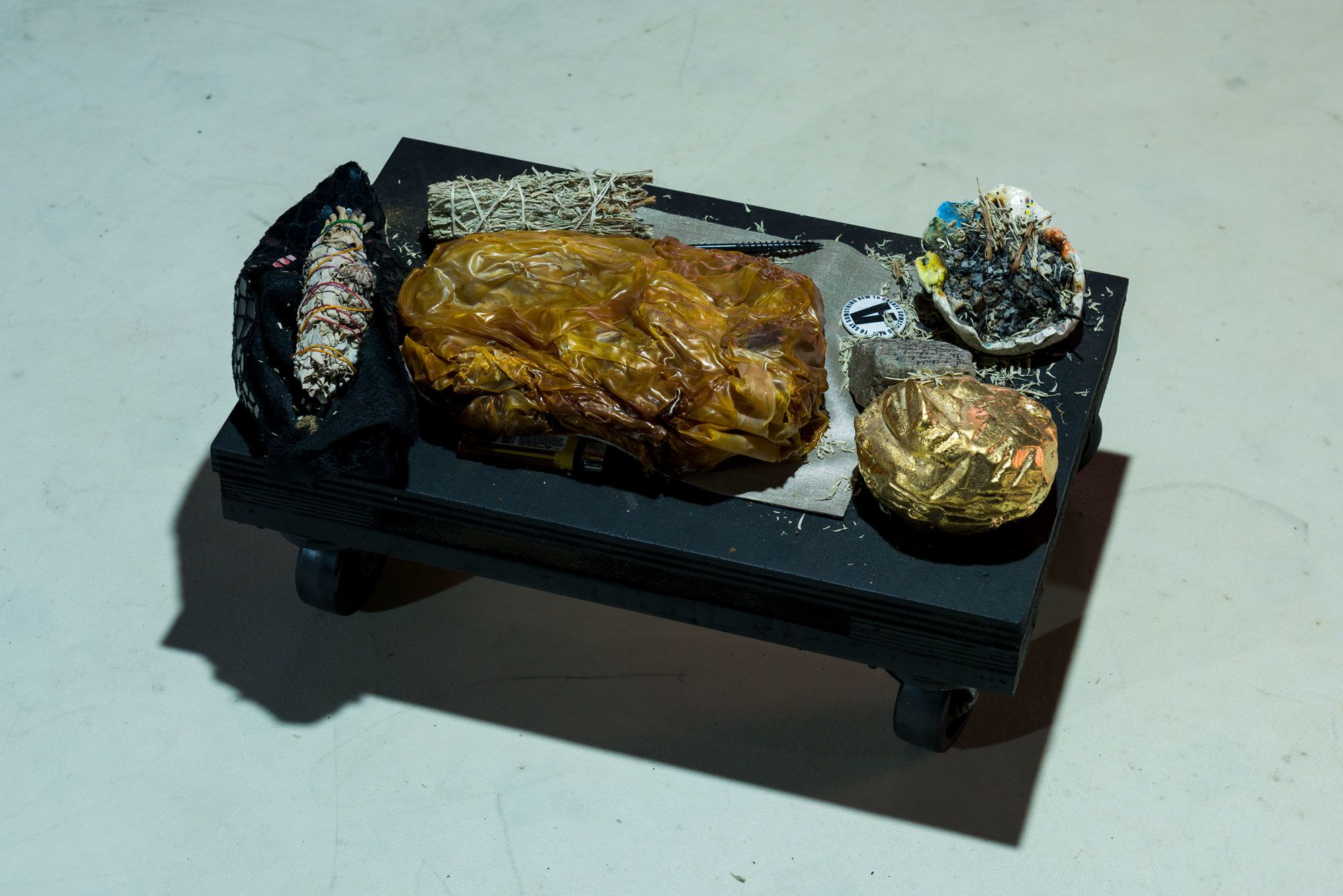
Jade Windscreen recipe
From Julie Tolentino:
JADE WINDSCREEN INGREDIENTS: Jade Windscreen includes just three herbs atractylodes rhizome (Bai zhu, 白朮), and siler root (Fang feng, 防風). Ancient Chinese physicians designed these formulas like families, with individual plants within the formula supporting each other, creating a harmonious whole.
Here’s more information about these three plants, including other herbal considerations.
Astragalus root (Astragalus membranaceus, Apiaceae. Huang qi, 黃芪): Astragalus supports immunity when one experiences qi deficiency, which may manifest as tiredness, weakness, or poor appetite. Its gentle flavor lends a subtle sweetness to decocted formulas and soups, while strengthening the digestive system, to support immunity. It is traditionally used in its sliced and dried form, though it can also be used as a powder or tincture. Note that astragalus can support health when one is weak, but it may “trap the thief in the house” if one is already sick, or it can tonify too much if one is already experiencing an “excess” condition. So, please use appropriately. Other immuno-modulating herbs according to Chinese medicine include reishi, codonopsis, and cordyceps.
Atractylodes rhizome (Atractylodes macrocephala, Asteraceae. Bai zhu, 白朮): Atractylodes’ bittersweet nature augments astragalus’ functions of tonifying the digestive system to support immunity. It further helps “dry dampness,” or move stagnant digestion. The Earth element governs digestion. Earth gives rise to Metal, which reinforces the “protective qi” (wei qi, 衛氣), which most closely correlates with the immune system. Likewise, the “three candies” of fresh ginger (sheng jiang, 生薑), Chinese date (da zao, 大棗), and licorice root (gan cao, 甘草) are often utilized together to harmonize a formula and promote digestive Earth-oriented stability.
Siler root (Saposhnikovia divaricata, Apioceae. Fang feng, 防風): Fang feng translates as “guard against wind.” In this formula, acrid- sweet siler root supports the “protective qi,” or immune system. By expelling wind, it is said to help address headaches, body aches, and spasms in other formulas. Other considerations for “expelling wind” include mint family plants such as catnip leaf (Nepeta), or perilla leaf (zi su ye).
HOW TO TAKE JADE WINDSCREEN: Jade Windscreen is traditionally prepared as a powder blend and taken dissolved in warm water. It can also be taken as a decoction with the raw dried herb, or in granule or capsule form. Astragalus is the “King herb” of the formula, thus the high dose. If the other herbs are not available, then consider simply making an astragalus decoction, or adding it to your broth or healing stews.
Jade Windscreen Powder Blend Recipe Ingredients
Directions: I commonly advise my clients to take 9 grams of Jade Windscreen powder blend dissolved in warm water 3 times per day. For the best guidance to support your specific needs, consult a qualified TCM practitioner. KAMWO in New York is a recommended source for herbs.
Carolina Caycedo and David de Rozas
2012
Video, color, silent, 2 min
For Caycedo and de Rozas' first collaboration, they compiled scenes of loved ones and exchanging greetings and farewells at a transit center. At the time, the two were in a long-distance, international relationship. Human emotional manifestations are present in any transportation station. The before and the after, the departure and the arrival, the greeting and the farewell, sorrow and happiness, the private in public. As everyday actors, we are the generators of all these situations.
On February 14, we hosted a gathering at the gallery. There was a planned activation for Suki Seokyeong Kang's show face, to be carried out by the artist Yong Soon Min. That morning, Suki had the idea of opening up the activation to more people and asked Young to participate. As the activation was about to start, Young called on all the gallery artists present to join in. Hence, you see in the video all the awkwardness of that moment, and the spontaneous magic of it too.
We did not know then that this would be the last time we would all be together for a while. As we take care of ourselves and our loved ones in isolation, we are reminded all the more that we are more powerful as a community, connecting with, supporting, and caring for one another, practicing generosity.
We are starting this page as a space in which we can share our thoughts, resources, things that help us cope with stress. We intend to allow it to take shape organically, not tied to any schedule or format. We believe this moment affords us an opportunity to disengage from the ceaseless churn of contemporary life as well.
We hope to be able to see you soon. In the meantime, please take care and stay safe.
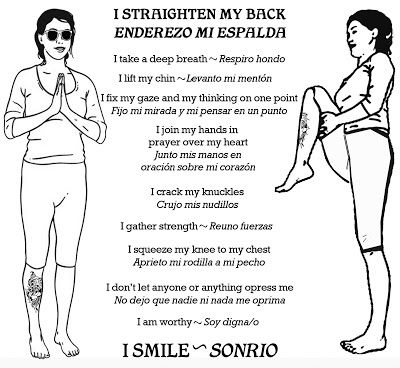
Carolina Caycedo
(Previously "Exercises for female emancipation")